Indonesian cuisine/ja: Difference between revisions
Created page with "===''トゥンペン''=== thumb|right|円錐形の黄色いご飯「[[Tumpeng/ja|トゥンペン・ナシ・クニン」が祝宴で提供される。]] {{main/ja|Tumpeng/ja}}" |
Created page with "多くのインドネシアの伝統的な習慣や儀式には食事や祝宴が組み込まれており、その最高の例の一つが「トゥンペン」である。もともとジャワ島発祥のトゥンペンは、2014年にインドネシアの国民食として公式に選ばれた、円錐形に盛られた米とそれに囲まれた様々なおかずの盛り合わせである。伝統的に「:en:slametan..." Tags: Mobile edit Mobile web edit |
||
| Line 427: | Line 427: | ||
{{main/ja|Tumpeng/ja}} | {{main/ja|Tumpeng/ja}} | ||
多くのインドネシアの伝統的な習慣や儀式には食事や祝宴が組み込まれており、その最高の例の一つが「[[tumpeng/ja|トゥンペン]]」である。もともと[[:en:Java|ジャワ島]]発祥のトゥンペンは、2014年にインドネシアの[[national dish/ja|国民食]]として公式に選ばれた、円錐形に盛られた米とそれに囲まれた様々なおかずの盛り合わせである。伝統的に「[[:en:slametan|スラマタン]]」の儀式で用いられ、円錐状の米は竹の葉を円錐形の容器に編み込んで作られる。米自体は、普通の白い蒸し米、「[[nasi uduk/ja|ウドゥク]]」(ココナッツミルクで炊いた米)、または[[nasi kuning/ja|黄色い米]](「クニート」、すなわち[[turmeric/ja|ターメリック]]で色付けした米)である。形を整えた後、米の円錐は、「[[urap/ja|ウラップ]]」野菜、フライドチキン、「セムール」(甘い醤油で煮込んだ牛肉)、テリ・カチャン(ピーナッツと一緒に揚げた小さな干し魚)、揚げエビ、「テルール・ピンダン」(大理石模様のゆで卵)、千切り卵焼き、「テンペ・オレック」(甘く乾燥した揚げ[[tempeh/ja|テンペ]])、「ペルケデル・ケンタン」(マッシュポテトのフリッター)、「[[perkedel/ja|ペルケデル]]・ジャグン」(コーンフリッター)、「サンバル・ゴレン・アティ」(チリソースで煮込んだレバー)など、様々なおかずで囲まれる。ナシ・トゥンペンは、山を祖先や神々の住処として崇拝する古代インドネシアの伝統に由来すると思われる。米の円錐は聖なる山を象徴するとされている。この祝宴は、豊かな収穫やその他の恵みに対する感謝の一種として提供される。そのお祭りや祝賀の価値から、現在でもトゥンペンは、[[birthday cake/ja|バースデーケーキ]]のインドネシア版として使われることもある。 | |||
<div lang="en" dir="ltr" class="mw-content-ltr"> | <div lang="en" dir="ltr" class="mw-content-ltr"> | ||
Revision as of 14:23, 23 June 2025

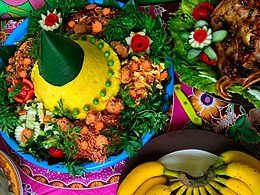 |
| この記事は下記のシリーズの一部です |
| インドネシア料理 Masakan Indonesia |
|---|
| Culture of Indonesia |
|---|
 |
| Cuisine |
| performing arts |
インドネシア料理は、インドネシアという群島国家を形成する様々な民族集団による、多様な地域の料理の伝統を集めたものである。インドネシアは、世界最大の群島を構成する合計17,508の島のうち、約6,000の有人島と600以上の民族集団からなるため、非常に多種多様な調理法と料理が存在する。
多くの地域料理があり、しばしば先住民族の文化を基盤とし、いくつかの外来の影響を受けている。
伝統と特徴
インドネシアには約5,350の伝統的なレシピがあり、そのうち30が最も重要とされている。インドネシア料理は、質素な地元の飲食店で提供される米、麺、スープ料理から、路上で売られるスナックや高価な料理まで多岐にわたる。
インドネシア料理は地域によって大きく異なり、様々な影響を受けている。例えば、スマトラ料理は中東やインドの影響を強く受けており、グライやカレーのようなカレー風味の肉料理や野菜料理が特徴である一方、ジャワ料理はほとんどが土着のもので、中華料理の影響がわずかに見られる。
東インドネシアの料理は、ポリネシア料理やメラネシア料理に似ている。中華料理の要素はインドネシア料理にも見られ、麺、肉団子、春巻き、ワンタンなどの食品は完全に同化している。
インドネシアは歴史を通じて、その立地と天然資源のために貿易に関わってきた。さらに、インドネシアの土着の技術と食材は、インド、中東、中国、そして最終的にヨーロッパの影響を受けた。スペインやポルトガルの商人たちは、オランダが群島の大部分を植民地化する以前から新世界の産物をもたらした。モルッカ諸島(マルク州)として知られるインドネシアの島々は「スパイス諸島」として有名であり、クローブやナツメグといった固有のスパイスをインドネシア料理や世界中の料理にもたらすのに貢献した。
インドネシア料理はしばしば、特定の食材と「ブンブ」(スパイスの混合物)から得られる複雑な風味を示す。インドネシア料理は豊かな風味を持ち、ほとんどの場合、うま味、辛味、そして甘味、塩味、酸味、苦味といった基本的な味の組み合わせとして表現される。ほとんどのインドネシア人は辛い食べ物を好むため、エビペースト、エシャロットなどの様々なオプションの材料が入ったインドネシアの辛いチリソースである「サンバル」は、すべてのインドネシアの食卓に欠かせない調味料である。インドネシアの7つの主要な調理方法は、揚げる、焼く、炙る、乾煎りする、炒める、煮る、蒸すである。

「ナシゴレン」、「ガドガド」、「サテ」といった人気のあるインドネシア料理は、国内で広く普及しており、国民食とされている。インドネシアの公式な国民食は「トゥンペン」であり、2014年にインドネシア観光創造経済省によって、インドネシアの多様な料理の伝統を結びつける料理として選ばれた。その後、2018年には同省がインドネシアの5つの国民食として、「ソト」、「ルンダン」、「サテ」、「ナシゴレン」、「ガドガド」を選定している。

現在、インドネシアを起源とする人気のある料理の中には、近隣国のマレーシアやシンガポールでも一般的になっているものがある。サテ、牛肉の「ルンダン」、「サンバル」といったインドネシア料理は、マレーシアやシンガポールで人気がある。豆腐やテンペのバリエーションといった大豆ベースの料理も非常に人気が高い。テンペはジャワの発明と見なされており、大豆をベースにした食品の発酵と生産の現地への適応である。もう一つの発酵食品は「オンチョム」で、テンペといくつかの点で似ているが、様々な基材(大豆だけでなく)を使用し、異なる菌類によって作られ、特に西ジャワで人気がある。
歴史

インドネシア料理には長い歴史がある。そのほとんどは十分に文書化されておらず、地域の慣習や口頭伝承に大きく依存している。稀な例としては、かなりよく文書化された料理の伝統を持つジャワ料理が挙げられる。その多様性は、インドネシア東部のパプア族によって実践されてきた古代の「バカール・バトゥ」(石で焼いたヤムイモやイノシシ)から、洗練された現代のインドネシアフュージョン料理まで多岐にわたる。インドネシアの諸島の民族的多様性は、地元のジャワ料理、スンダ料理、バリ料理、ミナン料理、マレー料理、その他の先住民の料理の伝統と、数世紀にわたるインドの商人、中国の移民、オランダの植民地との外国との接触を組み合わせた折衷的な組み合わせを提供している。

米はインドネシア社会にとって不可欠な主食であり、9世紀のボロブドゥールとプランバナンのレリーフには古代ジャワでの稲作が描かれている。古代の料理は多くのジャワの碑文に記されており、歴史家はそれらのいくつかを解読することに成功している。8世紀から10世紀頃のマタラム王国時代の碑文には、いくつかの古代料理が記されている。その中には、「hadaŋan haraŋ」(水牛のひき肉のサテで、今日のバリの「サテ・リリット」に似ている)、「hadaŋan madura」(甘いパームシュガーで煮込んだ水牛の肉)、そして「dundu puyengan」(レモンバジルで味付けしたウナギ)がある。また、「haraŋ-haraŋ」(グリルした肉)には、「celeṅ/wök」(豚肉)、「hadahan/kbo」(水牛)、「kidaŋ/knas」(鹿)、「wḍus」(ヤギ)などがある。古代の飲料には、「nalaka rasa」(サトウキビジュース)、「jati wangi」(ジャスミンドリンク)、「kinca」(タマリンドジュース)がある。また、様々な「クルバン」(スパイスで調理した茹で野菜で、今日の「ウラップ」に似ている)や「phalamula」(茹でたヤムイモや塊茎を液体のパームシュガーで提供するもの)がある。その他の古代の野菜料理には、「rumwah-rumwah」(「ララップ」)、「dudutan」(生野菜)、「tetis」がある。
9世紀の古ジャワのカカウィン・ラマヤナには、トリジャタがシータに食事を提供した際に調理技術について言及されている(canto 17.101)。「landuga tatla-tila」(油で調理したもの)と「modakanda sagula」(砂糖を使った菓子)という美味しい料理が提供された。
10世紀から15世紀にかけてのいくつかのジャワの碑文には、いくつかの食品が言及されている。これらの料理のいくつかは、現在のジャワの食品と同一視されている。その中には、「プチェル」、「ピンダン」、「rarawwan」(ラウォン)、「rurujak」(ルジャック)、「kurupuk」(クルプク)、菓子類では「wajik」や「dodol」、飲料では「dawet」がある。
15世紀のスンダの写本サンヒャン・シクサカンダ・ン・カレシアには、当時のスンダ料理の一般的な味として、「lawana」(塩辛い)、「kaduka」(辛い)、「tritka」(苦い)、「amba」(酸っぱい)、「kasaya」(香ばしい)、「madura」(甘い)が挙げられている。
13世紀から15世紀にかけて、沿岸部のインドネシアの政治勢力は、インドや中東からの料理の影響を吸収し始めた。これは、この地域でカレーに似たレシピが採用されたことから明らかである。これは特にアチェ、西スマトラのミナンカバウ地方、スマトラとマレー半島のマレーの港湾都市で顕著であった。その結果、これらの料理の伝統は、「kare」(カレー)、「roti cane」、「グライ」など、典型的なインド料理の影響を示している。これはまた、イスラム教の採用と並行して進み、豚肉を省く「ハラール」のイスラム教の食事規定を奨励した。一方で、バタック族やダヤク族など、内陸に住む先住民は、ブッシュミート、豚肉、血液を日常の食事に取り入れた、より古いオーストロネシアの料理の伝統を保持している。

17世紀のライクロフ・ファン・フーエンスの記録によると、VOCのスルタン・アグンのジャワマタラム宮廷への大使であった彼の記録では、ジャワでの祝祭における肉(羊、ヤギ、水牛)の調理法は、味付けした肉を焼いたり揚げたりすることであった。ヨーロッパ人とは異なり、ジャワ人は主にバターではなくココナッツオイルを使用していた。
中国人移民は、早くも西暦15世紀のマジャパヒト王国時代にインドネシア諸島に定住し、オランダ植民地時代に加速した。中国からの入植者は、炒め物の技術で、中華鍋と少量の食用油の使用を必要とするものを導入した。彼らはまた、醤油、麺類、豆腐を作るための大豆加工技術など、いくつかの新しい中華料理も導入した。その後、大豆加工は、おそらく偶然に「テンペ」(発酵大豆ケーキ)の発見につながった。テンペに関する最も初期の既知の言及は、1815年のジャワの写本セラット・チェンティーニに現れた。
大航海時代のスパイス貿易の活発化は、ヨーロッパの商人たちをインドネシアの海岸へと誘った。その後、19世紀にはオランダ領東インドにヨーロッパの植民地主義が確立された。ヨーロッパ料理、最も顕著にはポルトガルとオランダの影響は、ヨーロッパの技術、特にパン作り、ペストリー、クッキー、ケーキ作りに導入された。
インドネシアの料理の伝統は、様々な影響を受けてきた。食品加工技術の方法に関して、各地域は特異性を発展させ、それが最終的に地域の味の地域化につながっている。
習慣、配膳、食べ方

インドネシアの伝統的な食事は、通常、蒸しご飯を主食とし、その周りに野菜とスープ、肉や魚のおかずが並べられる。典型的な家族の食事では、家族が蒸しご飯といくつかのおかずが並べられたテーブルを囲む。それぞれの料理は別々の共有の大皿やボウルに入れられる。これらの料理にはそれぞれ専用の取り分け用スプーンがあり、共有の皿から自分の皿に料理を取り分けるためだけに使われる。家族の各メンバーは、最初に蒸しご飯が盛られた自分専用の皿を持っている。通常、最年長の家族または夫が食事を始める権利を持ち、その後、家族の残りの者が自由に料理を取り分ける。各自は共有の皿から自分の個々の皿に料理を盛る。

彼らの個人皿では、蒸しご飯はすぐに2、3種類以上の料理に囲まれることになる。野菜と魚または肉、そしておそらく揚げ物、サンバル、クルプクなどである。インドネシアの習慣では、日本とは異なり、食事中に異なる味付けの料理を一つの個人皿で混ぜて食べることがごく普通である。これは「ナシチャンプル」や「ナシパダン」、またはビュッフェでよく見られる習慣である。汁気の多い料理は別の小さな個人用の器で出されることもある。今日の現代的なインドネシアのレストランでは、セットメニューがしばしば提供されている。これにより、日本料理と同様に、お盆の上に個人皿があり、籐や竹の容器にそれぞれ少量の料理がご飯を囲むように並べられる個人配膳の習慣が生まれた。これは、バリのナシの盛り付けに見られる。

インドネシアの食事は、一般的に右手でスプーン、左手でフォーク(食べ物をスプーンに押し込むため)を使って食べる。ヨーロッパの食事の習慣とは異なり、食卓にはナイフが置かれないため、野菜や肉などの食材は調理前に一口大に切られている。ただし、西ジャワ、ゴロンタロ、西スマトラなど国内の多くの地域では、素手で食べることも一般的である。
シーフードの屋台、伝統的なスンダ料理やミナンカバウ料理のレストラン、東ジャワの「プチェルレレ」(ナマズのフライドにサンバル添え)や「アヤムゴレン」(フライドチキン)の屋台など、素手で食事をすることが一般的なレストランや家庭では、通常、食事と一緒に「コボカン」が出される。「コボカン」は、新鮮な香りを添えるためにライムのスライスが入った水道水のボウルで、この水は飲むためのものではなく、食事の前後で手を洗うために使われる。
箸を使って食事をするのは、一般的に、バクミーやミーアヤム(ワンタン入りチキンヌードル)、「ミーゴレン」(焼きそば)、クウェティヤウゴレン(平麺のライスヌードルの炒め物)など、インドネシア風にアレンジされた中華料理を提供する屋台やレストランに限られる。
主食
米

現代のインドネシアでは、米はあらゆる階層の主食であり、インドネシア文化の中心的な位置を占めている。米は風景を形作り、市場で売られ、ほとんどの食事で甘味と塩味の両方の料理として供される。インドネシア文化における米の重要性は、古代ジャワとバリの米の女神であるデウィ・スリへの崇敬によって示されている。伝統的に、米の栽培に関連する農業サイクルは、「セレン・タウン」米収穫祭などの儀式を通じて祝われていた。
米は、ほとんどの場合、プレーンなご飯として、少量のタンパク質と野菜のおかずを添えて食べられる。また、「ナシ・ウドゥク」(ココナッツミルクで炊いたご飯)、「ナシ・クニン」(ココナッツミルクとターメリックで炊いたご飯)、「クトゥパット」(ココナッツの葉を編んだ袋で蒸したご飯)、「ロントン」(バナナの葉で蒸したご飯)、「intip」または「レンギナン」(ライスクラッカー)、デザート、春雨、麺類、「arak beras」(米酒)、そして「ナシゴレン」(チャーハン)としても供される。「ナシゴレン」はインドネシアのどこにでもあり、国民食とされている。

米は、栽培技術を獲得するか、他の場所から購入する能力を獲得したときに初めて、食事に取り入れられた。スラウェシ島の野生米の証拠は紀元前3000年にまで遡る。最も初期の栽培の証拠は、8世紀の中央ジャワ島の石碑文から得られ、王が米で税を徴収していたことを示している。米の栽培、米倉、水田を荒らすネズミの害虫のイメージは、ボロブドゥールのカルマウィバンガのレリーフに明らかである。男性、女性、動物間の労働分担は、インドネシアの米栽培で今も行われているもので、9世紀のプランバナン寺院のレリーフ彫刻に刻まれている。中部ジャワでは、水牛が鋤につながれ、女性が苗を植えたり穀物を臼でひいたり、男性が肩に棒(「ピクラン」)の両端に稲束を担いでいる。16世紀、インドネシア諸島を訪れたヨーロッパ人は、米を儀式や宴会で貴族に供される新しい権威ある食べ物と見ていた。
インドネシアの歴史における米の生産は、鉄器の開発と、野生のアジア水牛の家畜化(田畑の耕作用の水牛として、また肥料用の肥料として)と関連している。米の生産には太陽光への露出が必要である。かつて密林に覆われていたインドネシアの景観の多くは、過去1500年間の米栽培の発展に伴い、恒久的な畑や居住地のために徐々に開墾されてきた。
小麦

小麦はインドネシアの原産植物ではない。輸入や外国の影響、特に中国やオランダの影響により、インドネシア人は小麦を主原料とする食品、特に中国の麺類、インドのロティ、オランダのパンを好むようになった。インドネシアの中国人は、一般的な蒸しご飯の他に、麺類、バクパオ、チャクウェも主食と見なしていた。しかしインドネシア、特にジャワ島とスマトラ島では、米文化が非常に普及していたため、麺類のような小麦を主原料とする料理もおかずとして米と一緒に食べられることがあり、また中華まんやチャクウェのような他のものは軽食として扱われている。ヨーロッパ人、特にポルトガル人とオランダ人は、パンや様々な種類のベーカリーやペイストリーを導入した。これらのヨーロッパの主食は、今では手軽な朝食の代替品となっている。
インドネシアの小麦消費量は、1970年代にインドネシアのインスタントラーメン産業が登場して以来、新たな高みに達した。それ以来、インドネシアは世界の主要なインスタントラーメン生産国および消費国の一つとなっている。インドネシアは中国に次ぐ世界第2位のインスタントラーメン市場であり、2018年の需要は125.4億食に達した。今日、インスタントラーメンはインドネシアの家庭で手軽な温かい食事の主食となっている。インドミーなどの特定のブランドは、おなじみの名前となっている。
その他の主食

インドネシアの他の主食には、イモ類であるヤムイモ、サツマイモ、ジャガイモ、タロイモ、キャッサバなどがある。パンノキやジャックフルーツなどのデンプン質の果物や、トウモロコシなどの穀物も食べられている。「パペダ」と呼ばれるサゴの粥は、特にマルク諸島とパプアの主食である。サゴは水と混ぜて簡単なパンケーキとして調理されることが多い。サゴの他に、インドネシア東部の人々は野生のイモ類を主食として消費する。
「タラス」(タロイモの一種だがより大きく味が薄い)やパンノキなど、多くの種類の塊茎はインドネシア原産だが、他は他の地域から導入されたものである。ヤムイモはアフリカから導入され、ジャガイモ、サツマイモ、キャッサバ、トウモロコシはスペインの影響でアメリカ大陸から導入され、17世紀にジャワ島に到達した。キャッサバは通常、茹でたり、蒸したり、揚げたり、または人気のあるスナックである「クリピック・シンコン」(キャッサバチップス)として加工される。地元で「ティウール」として知られる乾燥キャッサバは、グヌンキドゥルやウォノギリのようなジャワ島の乾燥地帯で代替の主食であり、他の根菜類は特に厳しい時期に食べられている。トウモロコシはマドゥラ島やウォーレス線以東の島々(例えば小スンダ列島)のような乾燥地帯で食べられている。
野菜

インドネシア料理では、葉物野菜が幅広く使われている。例えば、「カンクン」、ほうれん草、「ゲンジェル」、「ムリンジョ」、パパイヤの葉、キャッサバの葉などである。これらはしばしばニンニクと一緒に炒められる。ほうれん草とトウモロコシは、「テム・クンチ」、ニンニク、エシャロットで風味付けされた「サユール・バヤム・ベニン」のようなシンプルな澄んだ汁物に使われる。澄んだ野菜スープには「サユール・オヨン」も含まれる。ユウガオ、ハヤトウリ、「ケロール」、ササゲ、ナス、「ガンバス」、「ベルストゥル」などの他の野菜は、切って炒め物、カレー、そして「サユール・アセム」、「サユール・ロデー」または「ラクサ」のようなスープに使われる。「ダウン・ウビ・トゥンブク」は、スマトラ、カリマンタン、スラウェシで一般的に見られる、すり潰したキャッサバの葉の料理である。「サユール・ソップ」は、キャベツ、カリフラワー、ジャガイモ、ニンジンをマカロニ、黒コショウ、ニンニク、エシャロットで味付けし、鶏肉や牛肉のブロスで煮込んだものである。同様のミックス野菜は、インドネシア中華料理の人気料理である「チャプチャイ」としても炒められる。「トゥミス・カンクン」は、人気の空芯菜の炒め物である。
シカクマメ、トマト、キュウリ、小型のニガウリなどの野菜は、「ララブ」のように生のまま食べられることが多い。大型のニガウリは通常茹でて食べる。「ケチョンブラン」とパパイヤの花芽は、一般的なインドネシアの野菜である。「ウラップ」は、味付けされスパイスの効いたすりおろしたココナッツと野菜を混ぜたものである。「アシナン・ブタウィ」は、保存野菜である。「ガドガド」と「プチェル」は、茹でた野菜にピーナッツベースの辛いソースをかけたサラダで、「カレドック」は生の野菜を使ったものである。
インドネシアにおける菜食主義

菜食主義はインドネシアでよく見られる。豊富な種類のベジタリアン料理と、肉の代替品が提供されている。ユーロモニター・インターナショナルが2018年に実施した調査によると、インドネシアは菜食主義の成長率が3番目に高い国である。 「ガドガド」、「カレドック」、「ケトプラック」、「タウゲゴレン」、「プチェル」、「ウラップ」、「ルジャック」、「アシナン」などの料理はベジタリアン料理である。しかし、「ガドガド」、「カレドック」、「ケトプラック」のようなピーナッツソースを使う料理には、風味付けのために「テラシ」と呼ばれる少量のエビペーストが含まれている場合がある。エビペーストは、ララブ( assorted fresh vegetables)と一緒に提供される辛いサンバルチリペーストに風味を加えるためにもよく使われる。大豆の発酵製品であるテンペ、「タフ」(豆腐)、「オンチョム」は、肉の代替品として、また植物性タンパク質源として広く普及している。現代のフュージョン料理では、テンペはミートパティの代わりとして使われ、テンペバーガーとして提供されている。
ほとんどのインドネシア人は厳格な菜食主義を実践しておらず、味、好み、経済的、健康上の理由から野菜や菜食料理を摂取することがある。それでも、宗教的な理由で菜食主義を実践する少数のインドネシア仏教徒は存在する。
肉と魚
インドネシアの食事における主要な動物性タンパク質源は、主に家禽と魚であり、牛肉、水牛、ヤギ肉、羊肉などの肉類もインドネシアの市場で一般的に見られる。
鶏肉

最も一般的に消費される家禽は鶏肉と鴨肉で、ハト、ウズラ、ツルクイナなどの野生の沼地の鳥も消費される。伝統的に、インドネシア人は「アヤム・カンポン」(村の鶏)として知られる放し飼いの鶏を飼育している。一般的な飼育鶏と比較して、これらの村の鶏は痩せており、肉はわずかに固い。「アヤム・ゴレン」(フライドチキン)と「アヤム・バカール」(グリルチキン)の様々なレシピは、インドネシア全土で一般的に見られる。揚げたり焼いたりする以外に、鶏肉は「sup ayam」や「ソト・アヤム」のようなスープとして調理したり、「オポール・アヤム」のようにココナッツミルクで調理したりすることもある。鶏肉サテもインドネシアで一般的に見られる。串に刺してバーベキューにし、ピーナッツソースを添えて提供する。人気の鶏肉レシピには、ジョグジャカルタの「アヤム・ゴレン・カラスン」、パダンの「アヤム・バカール・パダン」、ロンボクの「アヤム・タリワン」、バリの「アヤム・ブトゥトゥ」、そして「アヤム・ゴレン・レンクアス」(ガランガル風味のフライドチキン)がある。
肉

牛肉とヤギ肉は、インドネシアで最も一般的に消費される肉であり、「kerbau」(水牛)と羊肉も消費されるが、水牛は水田を耕すのに役立ち、羊は羊毛のために飼育されたり、伝統的な娯楽である羊の闘いに使われたりするため、消費量は少ない。イスラム教徒が多数を占める国として、インドネシアのイスラム教徒はイスラム教のハラールの食事規定に従い、豚肉の消費を禁じている。
イスラム教徒以外の人が多いインドネシアの他の地域では、イノシシ肉と豚肉が一般的に消費される。ハラールでない肉を使った料理は、バリ、北スマトラ、北スラウェシ、東ヌサトゥンガラ、マルク、西カリマンタン、中央カリマンタン、北カリマンタン、西パプア、パプアなどの州や、インドネシアの主要都市の中華街で見られる。今日、より大きなイスラム市場に対応するために、インドネシアのほとんどのレストランや飲食店は、豚肉やハラールでない肉を提供せず、調理にラードを使用しないことを示すハラールサインを出している。圧倒的なイスラム教徒の人口と、比較的少ない牛の人口により、今日インドネシア人はオーストラリア、ニュージーランド、米国からの牛肉の輸入に大きく依存しており、インドネシア市場での牛肉の不足と価格上昇につながることが多い。
肉は、牛肉、ヤギ肉、または羊肉の「ルンダン」のように豊富なスパイスとココナッツミルクで調理したり、串に刺して味付けし、鶏肉や羊肉をサテとしてグリルしたり、バーベキューにしたり、スライスして「ソト」のように豊かなブロススープで調理したりすることができる。羊肉と様々な内臓は、ソトスープや「グライ」カレーの材料として使用できる。ヒンドゥー教徒が多数を占めるバリでは、「バビグリン」(豚の丸焼き)が地元の人々やイスラム教徒以外の観光客に人気がある。一方、北スマトラのバタク族は、「バビパンガン」という同様の料理がある。イノシシもパプアで一般的に消費される。肉は薄切りにして乾燥させた「デンデン」(ジャーキー)にしたり、「abon」(肉フレーク)にしたりすることもできる。「dendeng celeng」は、インドネシアの「乾燥ジャーキー」のイノシシ肉である。ウサギもインドネシアの山岳地帯で食用として消費されている。
鹿肉などの猟肉は、インドネシアの一部の地域で販売および消費されている可能性がある。カリマンタン、西ヌサトゥンガラ、東ヌサトゥンガラ、パプアでは、鹿肉を見つけることができ、通常は狩猟によって野生で入手する。その他の珍しい、そしてしばしば物議を醸すエキゾチックな肉には、インドネシア中華料理やジャワ料理で消費されるカエルの足やスッポン、ジョグジャカルタ、西ヌサトゥンガラ、南スラウェシで消費される馬肉、バリやインドネシア東部で消費されるカメの肉、ヘビ、「biawak」(オオトカゲ)、「paniki」(フルーツコウモリ)犬肉、猫肉、ミナハサ料理で消費される野ネズミがある。北スマトラのバタク料理も犬肉の調理に精通しているが、その消費は中央ジャワでは減少している。ワニ、リス、ジャコウネコ、サルなどのエキゾチックで珍しい猟肉も、インドネシアの野生地域で販売および消費されている可能性がある。
魚

群島国家であるインドネシアでは、シーフードが豊富であり、特に沿岸地域に住むインドネシアの住民によく消費されている。魚は、スラウェシやマルク諸島などのインドネシア東部地域で特に人気があり、ほとんどの人が漁師として働いている。どちらの地域も広大な海があり、多くの種類のシーフードがもたらされる。
インドネシア料理で人気のシーフードには、カツオ、マグロ、サバ、マナガツオ、カマスサワラ、サバヒー、アジ、アイゴ、アバリスト、カンパチ、グルクマ、ムロアジ、ヨコイトヨリ、マトウダイ、ハタ、タイ、イワシ、メカジキ、サメ、エイ、イカまたはコウイカ、エビ、カニ、ガザミ、ムール貝などがある。
シーフードはインドネシア全土で一般的に消費されているが、マルク諸島、ゴロンタロ半島、ミナハサ(北スラウェシ)料理で特に人気がある。シーフードは通常、グリル、煮込み、または揚げられる。「イカン・バカール」は、インドネシア全土で見られる人気の焼き魚料理である。スパイスで炒めたり、スープに入れたりする調理法も可能である。塩漬け魚は、塩で保存されたシーフードであり、インドネシアの市場でも見られる。
淡水漁業は、内陸地域や大きな川や湖のある地域で見られる。淡水魚は、西ジャワのスンダ料理で人気があり、北スマトラのバタク地方のトバ湖で捕獲または養殖されたり、リアウ、ジャンビ、南スマトラのマレー地方やカリマンタンの大きな川から採取されたりする。人気の淡水魚には、コイ、グラミー、ナマズ、「パンガシウス」、ライギョ、「トリコガステル」、キノボリウオ、ナイルティラピア、モザンビークティラピアなどがある。
昆虫

タイとは異なり、インドネシアでは昆虫は人気の食材ではなく、屋台料理として広く入手できるものでもない。ジャワ島では、地元の人々は特定の種類の昆虫を捕獲、飼育、販売しており、通常はペットの鳥の餌として新鮮または生きた状態で販売されている。それにもかかわらず、伝統的にインドネシアのいくつかの文化は、特にイナゴ、コオロギ、シロアリ、またサゴヤシゾウムシ、ミツバチ、トンボの幼虫を消費することで知られている。ジャワ島とカリマンタン島では、イナゴとコオロギは通常軽く衣を付けてパーム油で揚げ、「クリピック」のスナックとしてカリカリにしている。小型のイナゴ、コオロギ、シロアリは、昆虫の化石に似た「レンペ」バッタークラッカーとして作られることがある。モンスーンの雨季には、羽のあるシロアリが電球に引き寄せられて交尾するため豊富になる。地元の人々は通常、ランプの下に水の入ったバケツを置いて羽のあるシロアリを捕獲し、羽をもぎ取り、タンパク質が豊富な追加のスナックとしてシロアリをローストする。東ジャワのバニュワンギには、「ボトックタウォン」(ミツバチのボトック)と呼ばれる特別な料理があり、これはミツバチの幼虫を含む蜂の巣で、細かく刻んだココナッツとスパイスで味付けし、バナナの葉のパッケージに包んで蒸したものである。カリマンタンのダヤク族、またインドネシア東部のモルッカ族とパプア族は、「ulat sagu」(文字通りサゴイモムシ)またはサゴヤシゾウムシの幼虫を消費することで知られている。このタンパク質が豊富な幼虫はパプアでは珍味とされており、消費する前にローストされることが多い。地元の人々はまた、幼虫を生または生きたまま食べるのが一般的である。バリでは、トンボもペペスに加工して消費される。
スパイスとその他の調味料

「Rempah」はインドネシア語でスパイスを意味し、「ブンブ」はインドネシア語でスパイスミックスまたは調味料を意味し、特定のスパイスミックス、ソース、調味料ペーストの名前によく登場する。
「スパイス諸島」として世界中に知られているマルク諸島は、その地のスパイスを世界の料理に導入するのに貢献した。ナツメグまたはメース、クローブ、パンダンリーフ、クルワック、ガランガルなどのスパイスはインドネシア原産である。黒胡椒、ウコン、レモングラス、エシャロット、シナモン、カンドルナッツ、コリアンダー、タマリンドはインドから、ショウガ、ネギ、ニンニクは中国から導入された可能性が高い。これらのアジア大陸からのスパイスは古く、古代に導入されたため、インドネシア料理に不可欠な材料となった。
古代には、スンダ王国と後のバンテン・スルタン国は、世界の主要な黒胡椒生産国としてよく知られていた。シュリーヴィジャヤとマジャパヒトの海洋帝国も、スパイス諸島と中国およびインドとの間の儲かるスパイス貿易から利益を得ていた。その後、オランダ東インド会社がインドネシアと世界とのスパイス貿易を支配した。
サンバル

インドネシア人の辛い食べ物への好みは、16世紀にスペイン人が新世界からこの地域に唐辛子を導入したことで豊かになった。その後、辛い「サンバル」はインドネシア料理の重要な一部となった。
インドネシアにはおそらく最も豊富な種類のサンバルがある。インドネシア諸島には、実に300種類もの「サンバル」が存在する。その辛さはマイルドなものから非常に辛いものまで多岐にわたる。サンバルはインドネシア中で多くのバリエーションに発展し、最も人気のあるものの一つは「サンバル・テラシ」(サンバル・ブラチャン)と「サンバル・マンガ・ムダ」(未熟マンゴーのサンバル)である。「サンバル・テラシ」は、唐辛子、テラシと呼ばれる鋭い発酵エビペースト、ピリッとしたライム果汁、砂糖、塩をすべて乳鉢とすりこぎで潰したものである。ダブダブは、ゴロンタロと北スラウェシスタイルのサンバルで、刻んだ新鮮なトマト、唐辛子、ライム果汁を混ぜたものである。

サンバル、特にサンバル・ウレックやサンバル・テラシは、サンバル・ラジャ(クタの料理)、テロン・バラド、デンデン・バラド、アヤム・ブンブ・ルジャック、サンバル・ゴレン・アティなど、多くの料理の基本材料にもなる。
ソースと調味料
醤油もインドネシア料理における重要な調味料である。「Kecap asin」(塩辛い、または一般的な醤油)は中華料理から取り入れられたが、インドネシア人は醤油にパームシュガーをたっぷり加えて独自の「ケチャップ・マニス」(甘い醤油)を開発した。甘い醤油は、サテや焼き魚などのバーベキュー肉や魚の重要なマリネ液である。甘い醤油は、「セムール」というインドネシアの煮込み料理にとっても重要な材料である。
ピーナッツソース

インドネシア料理の主要な特徴の一つは、ピーナッツが「サテ」、「ガドガド」、「カレドック」、「ケトプラック」、「プチェル」など、多くの代表的なインドネシア料理に幅広く使われていることである。これらの料理はすべて、風味付けのためにたっぷりの「bumbu kacang」(ピーナッツソース)を使用している。「ガドガド」や「サテ」などは、インドネシアの国民食とされている。
16世紀にメキシコからポルトガル人やスペイン人の商人によって伝えられたピーナッツは、インドネシア料理の主要な食材として位置づけられた。ピーナッツは東南アジアの熱帯環境でよく育ち、今日では多くのレシピで、ローストして細かく刻んだものが見られる。丸ごと、半分、または砕いたピーナッツは、様々な料理の付け合わせに使われたり、「オタコタック」や「クタン」のための「サンバル・カチャン」(ひき肉と揚げピーナッツを混ぜたもの)のようなマリネ液やディップソースに使われたりする。ピーナッツから抽出されるピーナッツオイルは、インドネシアで最も一般的に使われる食用油の一つである。
「Bumbu kacang」またはピーナッツソースは、甘くてベタベタしたソースというよりは、洗練された素朴な調味料である。揚げたピーナッツ、グラ・ジャワ(ココナッツシュガー)、ニンニク、エシャロット、ショウガ、タマリンド、レモン汁、レモングラス、塩、唐辛子、粒胡椒、甘い醤油など、様々な材料を一緒に挽いて水と混ぜて適切な粘度にしたもので、香ばしさ、甘さ、酸味、辛味の繊細なバランスがとれているべきである。良いピーナッツソースの秘訣は、「濃すぎず、水っぽすぎない」ことである。インドネシアのピーナッツソースは、タイのバージョン(ハイブリッドな適応)よりも甘みが少ない傾向がある。「ガドガド」は「ブンブ・カチャン」と特に関連の深い人気料理であり、インドネシア全土で食べられている。
ココナッツミルク
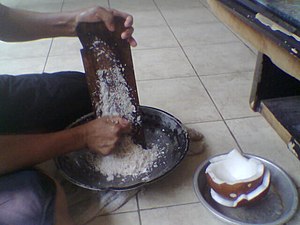
ココナッツは熱帯のインドネシアに豊富にあり、古くからインドネシア人はこの植物を様々な方法で利用してきた。諸島全体で料理にココナッツミルクが幅広く使われていることは、インドネシア料理のもう一つの共通の特徴である。ココナッツミルクは、「ルンダン」、「ソト」、「グライ」、「ミー・コチョック」、「サユール・ロデ」、「グデッグ」、「オポール・アヤム」のような塩味の料理から、「es チェンドル」、「エス・ドゲル」のようなデザートまで、幅広いレシピで使われている。
ココナッツミルクの使用は、インドネシア料理に限ったことではない。インド、サモア、タイ、マレーシア、フィリピン、ブラジルの料理にも見られる。しかし、インドネシアでは特にミナンカバウ料理やゴロンタロ料理でココナッツミルクの使用が非常に広範である。ただし、ミナハサ(北スラウェシ)料理では、「クラッパルタルト」のようなミナハサのケーキやデザートを除いて、ココナッツミルクは一般的に使用されない。

インドネシア料理には、薄いココナッツミルクと濃いココナッツミルクの2種類がある。違いは水分と油分の含有量による。薄いココナッツミルクは通常、「サユール・ロデ」や「ソト」のようなスープに使われ、濃い方は「ルンダン」やデザートに使われる。伝統的な市場では、すりおろしたばかりの新鮮なココナッツの果肉から作られるか、スーパーマーケットで加工されたカートン入りのものが見られる。
ココナッツの果肉からココナッツミルクを抽出した後、「ampas kelapa」(残ったココナッツの果肉)は、「urap」で、味付けされスパイスの効いたすりおろしたココナッツの果肉と野菜を混ぜて使用できる。残ったすりおろしたココナッツは、ソテーして味付けし、「セルンデン」という、ほとんど粉末状の甘くてスパイシーな細かく刻んだココナッツを作ることもできる。ケリシックペーストは、「ルンダン」を濃くするために加えられる、ココナッツの果肉のもう一つの用途である。豊かな味を出すために、一部の家庭では「ウラップ」や「セルンデン」に、残ったものではなく新鮮なすりおろしたココナッツを使うことにこだわる。「セルンデン」は、「セルンデン・ダギン」(牛肉のセルンデン)のような肉料理と混ぜたり、「ソト」や「クタン」(もち米)のような他の料理の上に振りかけたりすることができる。ココナッツの多用の一例は、マカッサルの「ブラサ」で、バナナの葉に包んだ米をココナッツミルクで炊き、セルンデンに似た粉状のココナッツを振りかけたものである。
調理法

インドネシアの一般的な料理のほとんどは、主要な材料と調理法にちなんで名付けられている。例えば、「アヤム・ゴレン」は「ayam」(鶏肉)と「goreng」(揚げる)から成り、フライドチキンを意味する。「ミー・ゴレン」は焼きそば、「イカン・バカール」は焼き魚、「udang rebus」は茹でエビ、「バビ・パンガン」はローストポーク、「tumis kangkung」は空芯菜の炒め物である。インドネシアの台所での調理法は、「goreng」(揚げる)は少量の油で揚げるか、多量の食用油で揚げるか、「tumis」(炒める)、「sangrai」(ソテーする)である。焙煎法は「bakar」(グリルする)で、通常木炭、薪、またはココナッツの殻を使用し、「panggang」(焼く/ローストする)は通常オーブンを使用するものを指す。その他の方法としては、「rebus」(茹でる)、「kukus」(蒸す)、「asap」/「salai」(燻製する)がある。
調理に使う火は、強火でも弱火でも、ゆっくり煮込むことができる。ナシゴレンの調理には通常強火を使うが、本格的な「ルンダン」は、牛肉、スパイス、ココナッツミルクを肉がキャラメル化し、ココナッツミルクの水分がすべて蒸発するまでゆっくり煮込むために弱火が必要である。伝統的なインドネシアの「dapur」(台所)は通常、薪を燃料とするかまどを使用するが、現代の家庭では液化石油ガスを燃料とするストーブや電気ストーブを使用している。材料は細かく切ったり、薄切りにしたり、ペースト状に挽いたりする。調理器具は「wajan」(中華鍋)、「penggorengan」(フライパン)、「panci」(大鍋)、包丁、数種類のスプーンとフォーク、「parutan」(おろし金)、「cobek」と「ulekan」(石製のすり鉢とすりこぎ)である。伝統的にインドネシア人は石製のすり鉢とすりこぎでスパイスや材料を粗いペーストや細かいペーストに挽いていた。今日ではほとんどの家庭でこの作業にブレンダーやフードプロセッサーを使用している。伝統的なインドネシアの調理器具は通常、石、土器、陶器、木材、編み込んだ竹や籐の容器またはフィルターで作られていたが、現代の調理器具、皿、容器は金属(鉄、錫、ステンレス鋼、アルミニウム)、陶磁器、プラスチック、ガラスを使用している。
国民食
当初、インドネシア独立初期には、どこにでもあり非常に人気のある「ナシゴレン」が、当時は非公式ながら共和国の国民食と考えられていた。そのシンプルさと多様性がその人気に貢献し、インドネシアの家庭料理の定番となった――厳密で固定されたレシピがないため、人々が自由に調理できることから、口語的に最も「民主的な」料理と見なされている。
インドネシアの家庭で日常的に消費されている「ナシゴレン」は、インドネシアの家族を象徴する典型的な料理と考えられていた。それは1964年ニューヨーク万国博覧会のインドネシア館内のインドネシア・シアターレストランのメニューにあり、紹介され、提供された。1960年代半ばのスカルノ政権末期の米国大使であったハワード・パルフレイ・ジョーンズは、彼の回顧録「インドネシア:可能な夢」の中で、「ナシゴレン」が好きだと語っている。彼はスカルノの妻の一人であるハルティニが作った「ナシゴレン」への愛着を述べ、これまで食べた中で最も美味しい「ナシゴレン」だと絶賛した。それにもかかわらず、サテ、「ソト」、「ガドガド」などの他の広く人気のあるインドネシア料理も強力な候補と考えられている。「ソト」はインドネシアのどこにでもあり、インドネシアの国民食の一つとされている。
2014年、インドネシア観光創造経済省はインドネシア料理を推進するため、「トゥンペン」をインドネシアの公式国民食に選定した。厳密には「トゥンペン」は中央の円錐状の米を指し、周囲の様々な料理はインドネシアの多様な料理の中から自由に選ばれるため、インドネシアの多様な食文化の多様性を結びつける国民食として理想的とされた。しかし、その後「トゥンペン」をインドネシア唯一の国民食とすることでは、インドネシアの食文化の多様性を表現するには不十分であると見なされた。後に2018年には、同省はさらに5つのインドネシア国民食を選定した。それらは「ソト」、サテ、「ナシゴレン」、「ルンダン」、「ガドガド」である。
サテと「ソト」は、インドネシアの無数の民族の文化的境界を超越し、これらの料理が極めて地域化され、全国的に様々なレシピに分岐しているため、インドネシアの国民食として推進するにふさわしい注目すべき自然な選択である。例えば、インドネシア全土にはサテと「ソト」の豊富なバリエーションがあり、スマトラ島からインドネシア東部まで多岐にわたる。それぞれの文化、民族、さらには都市がこれらの料理を採用し、それぞれの文化、伝統、創造性、地域に合わせた味と好み、そして地元の食材の入手可能性に応じて独自のバージョンを開発してきた。
地域料理
ジャカルタ

多様で折衷的なブタウィ料理のジャカルタは、中国、マレー、スンダ、アラブ、インド、ヨーロッパの料理の影響を受けている。人気のブタウィ料理には、「ナシ・ウドゥク」(ココナッツライス)、「サユール・アセム」(甘酸っぱい野菜スープ)、「アシナン」(漬物サラダ)、「ガドガド」(ピーナッツソースをかけた茹でまたは湯通し野菜サラダ)、「ケトプラック」(ピーナッツソースをかけた野菜、豆腐、米粉麺、餅)、そして「ケラック・テロール」(スパイスを効かせたココナッツオムレツ)がある。クレオールまたはハイブリッドな現象から生まれたブタウィ料理は、プラナカン料理と非常によく似ている。
西ジャワ

スンダ(西ジャワ)のテクスチャーの特色は、「カレドック」である。これはインゲン、もやし、キュウリをスパイシーなピーナッツソースで和えた新鮮なサラダである。辛いサンバルディップソースを添えたララブの生野菜は、スンダの家庭や飲食店でどこにでも見られる。その他のスンダ料理には、牛肉と卵の麺スープである「ミー・コチョック」や、ダイコンとレモングラスが入った牛肉と野菜のスープである「ソト・バンドン」がある。屋台で人気なのは、「クパット・タフ」(押し固めた米、もやし、豆腐に醤油とピーナッツソースをかけたもの)である。「コレナック」(甘いココナッツソースを添えた焼いた発酵キャッサバタパイ)と「ウレン」(ピーナッツソースを添えた焼いたもち米の塊)は、通常温かくして食べる料理である。
中央ジャワ

中央ジャワの料理はその甘さで知られており、ジャックフルーツで作られたカレーである「グデッグ」は特に甘い。ジョグジャカルタ市は「アヤム・ゴレン」(フライドチキン)と「クレポン」(パームシュガーの餡が入った緑色の米粉団子)で有名である。スラカルタ(ソロ)の名物料理には、「ナシ・リウェット」(ココナッツミルク、未熟なパパイヤ、ニンニク、エシャロットで炊いた米で、鶏肉または卵を添える)と「セラビ」(チョコレート、バナナ、またはジャックフルーツをトッピングしたココナッツミルクパンケーキ)がある。その他の中央ジャワの名物料理には、「プチェル」(ほうれん草ともやしにピーナッツソースをかけたもの)、「lotek」(野菜と押し固めた米にピーナッツソースをかけたもの)、そして「オポール・アヤム」(ココナッツソースで煮込んだ鶏肉)がある。
東ジャワ
東ジャワの料理は中央ジャワのそれと似ている。東ジャワの料理は中央ジャワの料理に比べて甘さが控えめで、辛みが強い傾向にある。魚介類や魚介類製品がかなり広く使われている。例えば、「テラシ」(乾燥エビペースト)や「プティス・ウダン」(エビペースト)などである。人気の料理には、ロントン・クパン(小さなアサリのスープとライスケーキ)、ロントン・バラップ(もやしと豆腐とライスケーキ)、サテ・クロポ(ココナッツビーフサテ)、セマンギ・スラバヤ(ミズワラビの葉にスパイシーなサツマイモソースをかけたもの)、プチェル・レレ(ナマズの揚げ物にご飯とサンバルを添えたもの)、ラウォン(黒い牛肉スープ)などがある。マランの料理には、バクソ・マラン(ワンタンと麺が入った肉団子スープ)や「orem-orem」(押し固めた米、テンペ、もやし、醤油、ココナッツ、ピーナッツ)などがある。
マドゥラ

マドゥラ島はジャワ島の北東海岸に位置する島で、東ジャワ州の一部として行政区画されている。東ジャワ料理が「petis udang」を使うのと同様に、マドゥラ料理はエビの代わりに魚から作られる「petis ikan」を加える。マドゥラ風サテはおそらくインドネシアで最も人気のあるサテの種類である。その人気料理には、「サテ・アヤム・マドゥラ」(ピーナッツソースをかけた鶏サテ)、「ソト・マドゥラ」(牛肉スープ)などがある。マドゥラサテには、マドゥラヤギサテの羊肉版もある。「スープ・カンビン」の羊肉スープもマドゥラで人気である。インドネシア諸島における主要な塩生産地であるため、マドゥラ料理は他の東ジャワ料理と比べて塩辛いことが多い。
バリ

バリ料理には、「ラワール」(刻んだココナッツ、ニンニク、唐辛子に、豚肉または鶏肉、血を混ぜたもの)がある。「ベベック・ベトゥトゥ」は、スパイスを詰めた鴨をバナナの葉とココナッツの殻で包み、燃えさかる穴の中で調理したものである。バリのサテ、通称「サテ・リリット」は、スパイスを効かせたひき肉を串に押し付けて作るもので、串はしばしばレモングラスの棒から作られる。「バビグリン」は、唐辛子、ターメリック、ニンニク、ショウガを詰めた豚の丸焼きである。 「バサ・ゲデ」または「バサ・ラジャン」は、多くのバリ料理の基本材料となるスパイスペーストである。
バタク

バタク族は「サクサン」を作るのに豚肉、あるいは犬肉を使用する。もう一つのバタク豚肉料理の特産品は「バビ・パンガン」で、肉を酢と豚の血で茹でてからローストする。もう一つのバタク料理、「ayam namargota」はスパイスと血で調理された鶏肉である。もう一つの注目すべきバタク料理は「arsik」で、スパイスとハーブで調理されたコイである。バタク料理では、アンダリマン(Zanthoxylum acanthopodium)がスパイスとしてよく使われる。
アチェ
アラブ、ペルシャ、インドの商人たちはアチェの料理に影響を与えたが、その風味は元の形から大きく変化している。その中には「カレ」または「グライ」として知られるカレー料理があり、これらはココナッツをベースにした濃厚な料理で、伝統的に牛肉、ヤギ肉、魚、鶏肉で作られていたが、現在は豆腐、野菜、ジャックフルーツでも作られている。人気の高いアチェ料理には、「ロティ・チャネ」、「ミー・アチェ」、「ナシ・グリ」などがある。
西スマトラ


水牛は西スマトラの象徴であり、「ルンダン」に使用される。ルンダンは豊かでスパイシーな水牛肉または牛肉の料理であり、ミナンカバウ文化の代表的な料理でもある。2017年には、ルンダンがCNNトラベルの読者投票で「世界で最もおいしい食べ物」に選ばれた。パダン料理は西スマトラ発祥であり、おそらく最も豊富な種類の「グライ」(肉、内臓、魚、または野菜のカレーの一種)を誇っている。パダンのお気に入り料理には、「アサム・パデ」(酸っぱくて辛い魚の煮込み)、「サテ・パダン」(パダンサテ)、「ソト・パダン」(パダンソト)、そして「カトゥペック・サユア」(米団子の野菜スープ)がある。この地域の料理には、ブキティンギの「ナシ・カパウ」があり、これはパダン料理に似ているが、より多くの野菜を使用している。「アンピアン・ダディア」(水牛のヨーグルトにパームシュガーシロップ、ココナッツの果肉、米を添えたもの)や「ブブル・カンピウン」(緑豆のお粥にバナナと米ヨーグルトを添えたもの)も西スマトラの特産品である。
伝統的に、ミナンカバウ族は「メラントゥ」(移住)文化に従い、熱心なレストラン経営者である。その結果、パダン料理のレストランチェーンはインドネシア全土および近隣諸国で見つけることができ、おそらくインドネシアで最も人気のある地域料理となっている。西スマトラ以外の地域、例えばジャワでは、ほとんどのパダン料理レストランでルンダンを作るのに水牛を使用しているが、販売目的で水牛肉が牛肉よりも「劣っている」そして安いという理由から、ルンダン・サピと称している。水牛肉はより硬いため、少なくとも3時間の調理時間が必要なルンダンにはより適しており、完全に調理されると牛肉と比べてより粗い食感とより赤い色を示す。
東スマトラ

スマトラ島東海岸の料理は、マラッカ海峡に面するインドネシアのスマトラ諸州に住むマレー人の料理の伝統を指す。これにはリアウ州、リアウ諸島州、ジャンビ州、そしてメダンとその周辺のムラユ・デリ地域における沿岸の北スマトラが含まれる。密接な民族的血縁関係とマレーシアのマレー人との近接性のため、両国間で多くの料理が共有されている。例えば、マレーシアの国民食である「ナシレマク」や「ナシ・ウラム」も、リアウとジャンビの郷土料理と見なされている。マレー料理はまた、西スマトラ、南スマトラ、アチェの隣接するミナンカバウ料理とも多くの共通点を持っている。例えば、「グライ」、「アサム・ペダス」、「pindang」、「カリ」、「ルマン」、「ルンダン」などを共有している。これは、ミナンカバウ族が文化的にマレー族と密接に関連しているという事実によるものである。「テンポヤック」(発酵ドリアンソース)と「サンバル・ブラチャン」は、スマトラとマレー半島両方でよく使われる調味料である。プラナカン料理のバリエーションである「ラクサ」(スパイシーな麺)や「オタコタック」も、リアウ諸島やメダンで見られる。群島のリアウ諸島州ではシーフード料理が人気だが、リアウ州やジャンビ州では、「パティン」(パンガシウス)、ナマズ、コイ、グラミーなどのスマトラの川の淡水魚が人気である。「グライ・イカン・パティン」はプカンバルの代表的な料理であり、「グライ・ケタム」(カニのグライ)と「ナシ・ゴレン・テリ・メダン」(メダンのイワシチャーハン)はメダンの代表的な料理である。
南スマトラ

パレンバン市は南スマトラの料理の中心地であり、「プンペック」で有名である。これは、揚げた魚とサゴの団子で、「エンペックエンペック」としても知られている。「プンペック」は、パームシュガー、唐辛子、タマリンド、酢から作られる独特の「クア・チュコ」という甘酸っぱくて辛いソースを添えて供される。「プンペック」派生の料理には、「テクワン」というプンペック団子、キノコ、野菜、エビのスープ、「レンギャン」またはオムレツに入ったプンペックのスライスなどがある。「ミー・チェロル」は、ココナッツミルクと乾燥エビが入った卵麺料理で、パレンバンの名物である。
パレンバン料理は、パレンバンのマレー本来の味から中国やジャワの影響まで、様々な影響を示している。「プンペック」は「すり身」に似た中国の魚団子の影響を受けていると言われ、ほのかな甘さの好みはジャワの影響であると言われている。南スマトラは、「ピンダン」の本場である。これは、醤油とタマリンドで作られた甘酸っぱくて辛い魚のスープである。「ピンダン」料理は通常、淡水魚やシーフードを材料に使う。「イカン・ブレンケス」は、辛いドリアンベースのソースで魚を煮込んだものである。「テンポヤック」は、エビペースト、ライムジュース、唐辛子、発酵ドリアンで作られたソースであり、「サンバル・ブア」は果物から作られたチリソースである。
北スラウェシ
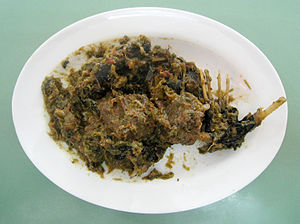
北スラウェシのミナハサの人々のマナド料理は、豚肉、鶏肉、シーフードなどの肉を大量に使うのが特徴である。「ウォク」は、スパイスをふんだんに使ったシーフード料理の一種で、しばしば料理の半分を占める。材料にはレモングラス、ライムの葉、唐辛子、ネギ、エシャロットが含まれ、肉と一緒に炒めるか、魚の周りに巻いてバナナの葉で包んで焼く。ターメリックやショウガなどの他の材料がしばしば加えられ、ウォクのバリエーションが作られる。その他のミナハサの代表的な料理は、「ティヌトゥアン」、チキン「tuturuga」、「リカリカ」、そして「チャカラン・フフ」である。
外国の植民地支配はミナハサ料理の形成に影響を与えた。いくつかのケーキや菓子は、オランダ、ポルトガル、スペインの影響を明確に示しており、例えば「クラッパルタルト」や「パナダ」などがある。「ブレネボン」(オランダ語の「bruin」(茶色)と「boon」(豆)に由来)は、ナツメグとクローブで味付けされた豚のスネ肉と豆の煮込みである。フィリピンのレチョンやハワイの豚の丸焼きに似たミナハサのローストポークは、特に結婚式などの特別な行事で提供される。北スラウェシ地域では、犬肉、コウモリ肉、森林ネズミなどの珍しいエキゾチックな肉も定期的に提供されている。「パニキ」はミナハサのコウモリ料理である。
ゴロンタロ

ゴロンタロの戦略的な位置、つまり北のセレベス海と太平洋、そして南のトミニ湾に挟まれた位置は、過去にゴロンタロ地方を戦略的な海上輸送路としていた。この長い歴史は、その独自の料理を含むゴロンタロの独特で特徴的な文化のルーツを形成した。そのため、ゴロンタロは独特の料理の味を持つスパイスの地としても知られている。
ゴロンタロ料理は、新鮮なシーフードが特徴で、あらゆるスパイスとハーブを使って調理される。ビンテ・ビルフタ、「アヤム・イロニ」、「イカン・イロニ」、サテ・マグロ、「タブ・モイトモ」、「サテ・バランガ」、「サゲラ」、「ピリトデ」、「ビレンタング」などのゴロンタロの珍味がある。
ゴロンタロ料理は、アラブ人や中国人の文化など、ゴロンタロに移住してきた他のコミュニティからの多文化の影響も受けている。さらに、ゴロンタロの菓子は、オランダによってもたらされたヨーロッパ文化の影響を受けており、その甘さでも有名である。
2016年、ゴロンタロ料理のレシピ本「Trailing the Taste of Gorontalo」が、煙台(中国)で開催されたグルマン世界料理本大賞のアジア料理部門(アジア書籍カテゴリー)で「世界最高賞」を受賞した。
南スラウェシ

マカッサルはインドネシアの食の中心地の一つである。ブギス族とマカッサル族の珍味である「コト」、「コンロ」、「パルバサ」、「ミー・ケリン」の発祥地である。これらのマカッサル料理はすべて、蒸した米やクパットの代わりに、バナナの葉で包まれたココナッツミルクの米団子であるブラサと一緒に食べられることが多い。大きな魚市場の中心であるため、マカッサルはシーフードでも有名である。様々な「イカン・バカール」、すなわち焼き魚がマカッサルのレストラン、ワルン、屋台で人気があり、よく提供される。例えば「イカン・ボル・バカール」(焼きサバヒー)などである。パンカジェネ諸島県の「ソップ・サウダラ」やパロポの「カプルン」も南スラウェシの有名な料理である。マカッサルで人気のあるもう一つの料理は「アヤム・ゴレン・スラウェシ」(セレベス風フライドチキン)である。鶏肉は伝統的な醤油に最長24時間漬け込まれてから黄金色に揚げられる。この料理は通常、鶏肉のスープ、米、特製「サンバル」(チリソース)と共に提供される。
さらに、マカッサルは「ピサン・エペ」(押しバナナ)や「ピサン・イジョ」(緑バナナ)などの伝統的な甘いスナックの本場でもある。「ピサン・エペ」は、平らに焼いたバナナを押し潰し、グリルし、パームシュガーソースをかけたもので、時にはドリアンと一緒に食べられる。ロサリビーチ周辺では、多くの屋台が「ピサン・エペ」を販売している。「ピサン・イジョ」は、緑色の小麦粉、ココナッツミルク、シロップで覆われたバナナである。「ピサン・イジョ」は冷やして提供されることもあり、ラマダン中の断食明けに売られ消費されることが多い。
ヌサ・トゥンガラ

ヌサ・トゥンガラ諸島は乾燥した気候のため、中央インドネシアや西インドネシアに比べて米が少なく、サゴ、トウモロコシ、キャッサバ、タロイモが多い。魚はよく食べられ、「セパット」(スリースポットグラミー)はココナッツと若いマンゴーソースにほぐした魚である。ロンボクのササク族は、ローストチキンにピーナッツ、トマトチリ、ライムのディップを添えた「アヤム・タリワン」のような辛い食べ物を好む。「ペレシング」は、チリ、エビペースト、トマトで作られた多くの料理に使われる辛いソースである。ロンボク島では「レンカレ」と呼ばれる地元のエビペーストが使われる。「サレス」は、チリ、ココナッツジュース、バナナヤシの髄から作られ、時には肉と混ぜられる。肉を含まない料理には、「ケロール」(野菜入り熱いスープ)、「セレブク」(野菜とココナッツを混ぜたもの)、そして「ティムン・ウラップ」(キュウリとココナッツ、タマネギ、ニンニク)がある。
東ヌサトゥンガラ州では、住民の大多数がカトリック教徒であるため、豚肉が一般的に消費される。人気のティモール料理は「セイ」(通常豚肉)という燻製肉と、「カテマック」という野菜スープである。
マルクとパプア

マルク諸島の料理は魚介類が豊富である一方、先住民のパプア料理は通常、サツマイモやタロイモなどのイモ類を添えたローストイノシシで構成されている。様々な種類の「イカン・バカール」(焼き魚)や魚介類は、辛い「コロコロ」という調味料と共に食べられる。マルクとパプアの主食はサゴで、パンケーキとしても、また「パペダ」と呼ばれるサゴの粥としても食べられる。これは通常、マグロ、フエダイ、またはターメリック、ライム、その他のスパイスで味付けされた他の魚から作られた黄色いスープと共に食べられる。
外国からの影響

インドからの影響
インド料理の影響は、早くも4世紀にはインドネシアで確認できる。イスラム教がインドネシアに広がるにつれて、イスラム教徒のインド人やアラブ人の影響がインドネシア料理に入り込んだ。料理史を専門とするジャーナリスト、アンドレアス・マリョトは、インドネシアに伝わったインド料理の影響には少なくとも2つの波があったと示唆している。初期の到来は、現在もジャワ島で見られるヒンドゥー文化の導入によって特徴づけられる。2番目の波はムガル帝国からもたらされ、群島に浸透したイスラム文化の影響を受けていた。このインド料理の影響の2番目の波は、スマトラ島北部、特にアチェ州と西スマトラ州のほとんどで見られる。例としては、アチェ、ミナンカバウ、マレーのスマトラ料理に影響を与えたインドの「マルタバク」や「カリ」(カレー)があり、加えてブタウィ料理や沿岸のジャワ料理も含まれる。「ロティ・チャナイ、ナシ・ビリヤニ、ナシ・ケブリ」、そして「グライ・カンビン」などのアチェやミナンカバウの料理には、インドの影響がその起源をたどれるものがある。
アラブからの影響
アラブ系インドネシア人は、もともとハドラマウト、ヒジャーズ、エジプト発祥のアラブ料理の遺産をもたらし、インドネシアの食材を加えて一部の料理を改良した。アラブ人は貿易とイスラム教の布教のためにヌサンタラ諸島に到着した。例えば、「ナシ・ケブリ」は、アラブ系インドネシア人コミュニティで人気のある料理であり、インドネシアの主流料理にも入ってきている。マルクでは、ラマダン中のイフタール(断食明け)に提供される「クエ・アシダ」が、アラブ商人がマルク諸島に持ち込んだ中東のアシダに由来すると考えられている。
中国からの影響

インドネシアへの中国人移民は7世紀に始まり、オランダ植民地時代に加速し、中国料理とインドネシアの土着の様式との融合を生み出した。同様の中国と現地の融合料理の現象は、隣国のマレーシアやシンガポールでもプラナカン料理として見られる。
インドネシア料理に影響を与えた中国の調理スタイルは、主に福建料理であった。中国系インドネシア料理の一部は、福建語の名前を保持している。例えば、「クウェティアウ」、「バクミ」、「バクチャン」、「ビーフン」、そして「ルンピア」である。「バクソ」、「ソト・ミー」、「ソト」、「バクパウ」、「ナシゴレン」、「ミー・ゴレン」、「タフ・ゴレン」、「ショウマイ」、「プンペック」、「ナシ・ティム」、「チャプチャイ」、「フーユンハイ」、そして「スイキー」といった人気のあるインドネシア料理は、中国の影響にその起源をたどることができる。これらの中国の影響を受けた料理の中には、インドネシアの主流料理に非常によく溶け込んでいるため、今日の多くのインドネシア人がその中国起源を認識せず、自国の料理と見なしているものもある。
オランダからの影響

オランダ人は16世紀に香辛料を求めてインドネシアに到着した。1800年にオランダ東インド会社(VOC)が破産すると、インドネシアはオランダの貴重な植民地となった。植民地主義を通じて、ヨーロッパ人はパン、チーズ、バーベキューのステーキ、パンケーキをもたらした。パン、バター、マーガリン、チョコレートのスプリンクル、ハム、チーズ、またはフルーツジャムを挟んだサンドイッチ、「ポファチェス」、「パンネクック」、そしてオランダのチーズは、植民地時代に植民地のオランダ人やインド人に一般的に消費されていた。一部の先住民の上流階級の「ニングラット」(貴族)や教育を受けた先住民はヨーロッパ料理に触れていた。この料理は、オランダ領東インド社会の上流階級の料理として高く評価された。
これがヨーロッパ料理のインドネシア料理への導入と融合につながった。いくつかのインドネシア料理は、オランダの影響にその起源をたどることができる。例えば、オランダの「オリエボーレン」に由来する「クエ・オダディン」、オランダの「smoor」に由来する「セムール」、フリカデッラーに由来する「ペルケデル」、「エルテンソープ」に由来する「ソップ・セネレック」、「ホーランド・ビーフステーク」に由来する「スラット・ソロ」(ソロ風サラダ)などである。

植民地時代に作られた料理には、オランダ料理の影響を受けたものが多く、「ロティ・バカール」(焼きパン)、「ロティ・ブアヤ」、「マカロニ・スコテル」(マカロニキャセロール)、「パステル・トゥトゥップ」(シェパーズパイ)、「ビスティック・ジャワ」(ジャワ風ビーフステーキ)、「エルテン」(豆のスープ)、「ブレネボン」(腎臓豆スープ)、そして「ソップ・ブンツット」などがある。
「クエ・ボル」(タルト)、「ラピス・レギット」(「スペククック」)、「ラピス・スラバヤ」(「スピク」)、「クロケット」(コロッケ)、「クエ・ボル・カナリ」(「オントバイトクック」)、そして「カステンゲル」(「カーステンゲルス」またはチーズスティック)などの多くの菓子、ケーキ、クッキーは、オランダの影響に由来する。一部のレシピは、現地の食材を使用しながらヨーロッパの製菓技術を応用したオランダ領東インドの融合料理として発明された。これらにはパンダンケーキや「クラッパルタルト」(ココナッツタルト)が含まれる。「クエ・チュビット」は、学校や市場でスナックとして一般的に販売されており、「ポファチェス」に由来すると考えられている。
海外への影響
逆に、インドネシア料理は、共通の植民地時代の遺産を通じてオランダにも影響を与えた。また、インドネシア人がマラッカ海峡を越えてマレーシアやシンガポールへ移住したことにより、近隣諸国にも影響を与えている。
マレーシア

地理的な近さ、歴史的な移住、そして密接な文化的血縁関係から、インドネシア料理は近隣の調理法にも影響を与えてきた。その中でも特に顕著なのがマレーシア料理である。インドネシアの影響は、西スマトラ州出身のミナンカバウ族が多数移住してきた中央のヌグリ・スンビラン州において広範に見られ、その文化、歴史、料理に反映されている。ミナンカバウ料理の影響はマレー料理の伝統に深く、その結果、両方の伝統が「ルンダン」、「グライ」、「アサム・ペダス」、「テンポヤック」といった同じ料理を共有している。ルンダンは、マレーシアの主流料理に非常によく溶け込み、今や彼ら自身のものと見なされており、特に「ハリ・ラヤ・アイディルフィトリ」の期間中に人気がある。20世紀初頭には、スマトラ島民がクアラルンプールやマレーシア本土の他の地域に大量に流入し、それがマレーシアだけでなくシンガポールでも「ナシ・パダン」(西スマトラ州のパダン市発祥)の人気につながった。
最南端のジョホール州のマレー料理は、過去2世紀にわたってそこに定住したジャワ人の影響を反映している。ジョホール州で人気のジャワ起源の料理には、「アヤム・ペニエット」、「ナシ・アンベン」、「テルール・ピンダン」、「サユール・ロデ」、「ミー・ルブス」、「ペチャル」などがある。
シンガポール
シンガポールの一部の料理はインドネシア料理の影響を受けている。サテ・ビーフンはジャワ料理と関連がある。この料理は潮州華僑とジャワの料理文化の産物であった。シンガポールのロジャックはインドネシアにルーツを持つ。菓子やペストリーにおいては、インドネシアの伝統的な「クエ」スナックやデザートも、インドネシア系中国人の起業家アナスタシア・リューが都市国家に移住し、シンガポールの代表的な存在となったブンガワン・ソロ菓子店を設立したことで、シンガポールの「クエ」業界に影響を与えた。
タイ

それほどではないが、インドネシア料理はタイ料理にも影響を与えている。おそらくマレーシアを介して、例えばサテがジャワ島からスマトラ島、マレー半島を経てタイに伝わったように。「アチャート」(Thai: อาจาด th)はタイの漬物で、インドネシアの「アチャール」に由来すると考えられている。キュウリ、赤唐辛子、赤玉ねぎまたはエシャロット、酢、砂糖、塩で作られる。タイ版のサテ(Thai: สะเต๊ะ)の付け合わせとして供される。
オランダ

植民地時代、オランダ人は国内外でインドネシア料理を取り入れた。インドネシアの独立後、本国送還された植民地のオランダ人やインド人がインドネシア料理をオランダに持ち帰ったことにより、インドネシア料理はオランダに影響を与えた。
C. 伯爵夫人ファン・リンブルフ・スティルムは、著書「オランダ料理の芸術」(1962年)の中で次のように書いている。「数え切れないほどのインドネシア料理が存在し、中には準備に何時間もかかるものもありますが、いくつか簡単なものは非常に人気があり、”国民食”と見なされるまでになりました。」そして彼女は、「ナシゴレン」(炒めご飯)、「ピサン・ゴレン」(衣を付けて揚げたバナナ)、「ルンピア・ゴレン」(揚げ春巻き)、「バミ」(焼きそば)、「サテ」(串焼き肉)、「サテ」ソース(ピーナッツソース)、そして「サンバル・ウレック」(チリペースト)のレシピを提供している。
オランダとインドネシアの融合料理も存在し、最も有名なのは「ライスターフェル」(「米のテーブル」)である。これは、多くの(数十種類に及ぶ)小皿料理からなる手の込んだ食事である(そのため「テーブル全体」を埋め尽くす)。オランダでは人気があるが、ライスターフェルは現在、インドネシア国内では珍しい。今日、オランダには多くのインドネシア料理レストランがあり、特にアムステルダム、ハーグ、ユトレヒト、ロッテルダムなどの大都市に多い。
食文化外交

インドネシア料理は伝統的に、マレーシア、シンガポール、ブルネイ、オーストラリアといった近隣諸国、そしてオランダ、スリナム、東ティモール、南アフリカなどインドネシアと歴史的つながりを持つ国々で人気を博してきた。また、日本や韓国でも人気が高まっている。

タイ、韓国、日本などの他国の食文化外交の成功から学び、2021年にインドネシア政府は、組織的なガストロノミー外交活動の一環として「インドネシア・スパイス・アップ・ザ・ワールド」プログラムを立ち上げた。このプログラムは、海外におけるインドネシア料理の振興、現地のスパイス製品や加工食品の国際市場への参入支援、そして海外のインドネシア料理レストランの支援を目的として開始された。
「インドネシア・スパイス・アップ・ザ・ワールド」プログラムには、政府省庁間機関、インドネシア食品産業、そして一般市民が関与している。このプログラムの目標は、インドネシアのスパイスとハーブの輸出額を20億ドルに引き上げ、2024年までに海外のインドネシア料理レストランの数を4,000軒に増やすことである。
食事の時間

インドネシア人は一日を通してスナックや様々な小皿料理を摂取することがある。もし別途予定された大きな食事がとられる場合、通常は「sarapan」または「makan pagi」(朝食)、「makan siang」(昼食)がその日の主要な食事となることが多く、その後「makan malam」(夕食)が続く。食事は一般的にカジュアルで一人でとられることが多く、地域によって異なる場合がある。
インドネシア西部と中央部では、主な食事は通常午前遅くに調理され、正午ごろに食べられる。多くの家庭では、家族全員が集まる決まった食事の時間はない。このため、ほとんどの料理は、室温で何時間もテーブルに置いたままでも食べられるように作られている。同じ料理は、夜の最後の食事のために温め直される。ほとんどの食事は、円錐形に高く盛られた長粒でよく精米された米を中心に構成されている。食事には、スープ、サラダ(またはより一般的にはニンニクで炒めた野菜)、そしてもう一品主菜が含まれる場合がある。どんな食事であっても、少なくとも1つ、しばしば数種類の「サンバル」と呼ばれる薬味が添えられる。特にジャワの家庭では、食事のお供として「クルプック」、「レンペヤック」、またはその他のチップスを常に用意しておくことが一般的である。
東インドネシア、例えばパプア島やティモール島など気候が乾燥していることが多い地域では、食事はサゴや根菜、デンプン質の芋類など他の炭水化物を中心に構成されることがある。ウォーレス線の東に位置するため、生物地理学的領域、ひいては植物相や動物相が西の島々とはかなり異なり、そのため食材も異なる。
祝宴
トゥンペン

多くのインドネシアの伝統的な習慣や儀式には食事や祝宴が組み込まれており、その最高の例の一つが「トゥンペン」である。もともとジャワ島発祥のトゥンペンは、2014年にインドネシアの国民食として公式に選ばれた、円錐形に盛られた米とそれに囲まれた様々なおかずの盛り合わせである。伝統的に「スラマタン」の儀式で用いられ、円錐状の米は竹の葉を円錐形の容器に編み込んで作られる。米自体は、普通の白い蒸し米、「ウドゥク」(ココナッツミルクで炊いた米)、または黄色い米(「クニート」、すなわちターメリックで色付けした米)である。形を整えた後、米の円錐は、「ウラップ」野菜、フライドチキン、「セムール」(甘い醤油で煮込んだ牛肉)、テリ・カチャン(ピーナッツと一緒に揚げた小さな干し魚)、揚げエビ、「テルール・ピンダン」(大理石模様のゆで卵)、千切り卵焼き、「テンペ・オレック」(甘く乾燥した揚げテンペ)、「ペルケデル・ケンタン」(マッシュポテトのフリッター)、「ペルケデル・ジャグン」(コーンフリッター)、「サンバル・ゴレン・アティ」(チリソースで煮込んだレバー)など、様々なおかずで囲まれる。ナシ・トゥンペンは、山を祖先や神々の住処として崇拝する古代インドネシアの伝統に由来すると思われる。米の円錐は聖なる山を象徴するとされている。この祝宴は、豊かな収穫やその他の恵みに対する感謝の一種として提供される。そのお祭りや祝賀の価値から、現在でもトゥンペンは、バースデーケーキのインドネシア版として使われることもある。
Having Nasi Padang in festive hidang (serve) style provides opportunity to sample wide array of Padang food in a single setting. Nasi Padang (Padang-style rice) is the steamed rice served with various choices of pre-cooked dishes originated from Padang city, West Sumatra. It is a miniature banquet of meats, fish, vegetables, and spicy sambals eaten with plain white rice. It is the Minangkabau's great contribution to Indonesian cuisine.
After the customers are seated, they do not have to order. The waiter with stacked plates upon their hands will immediately serves the dishes directly to the table. The table will quickly be set with dozens of small dishes filled with richly flavoured foods such as beef rendang, various gulais, curried fish, stewed greens, chili eggplant, curried beef liver, tripe, intestines, or foot tendons, fried beef lung, fried chicken, and of course, sambal. A dozen of dishes is a normal number, it could reach 14 dishes or more. Nasi Padang is an at-your-table, by-the-plate buffet. Customers take — and pay for — only what they have consumed from this array.
Another Indonesian feast, the Rijsttafel (from Dutch, meaning 'rice table'), demonstrates both colonial opulence and the diversity of Indonesian cuisine at the same time. The classic style rijsttafel involved serving of up to 40 different dishes by 40 male waiters, bare foot but dressed in formal white uniforms with blangkon (traditional Javanese caps) on their heads and batik cloth around their waists. In contemporary Indonesian cuisine, it has been adapted into a western style prasmanan buffet.
Prasmanan

When attending the reception of an Indonesian traditional wedding party, office lunch-time meeting, a seminar or dinner gathering, one usually will find themselves queuing to Indonesian prasmanan; a long table filled with wide array of Indonesian dishes. A prasmanan is quite similar with rijsttafel but minus the ceremonial waiters and usually served fewer choices of dishes compared to its flamboyant colonial predecessor. It is an Indonesian buffet as it employs a long table with a wide range of dishes, both savoury and sweet, served on it. It can usually be found in wedding ceremonies or any other festivities. The layout for an Indonesian wedding ceremony buffet is usually: plates, eating utensils (spoon and fork), and paper napkins placed on one end, followed by rice (plain or fried), a series of Indonesian (and sometimes international) dishes, sambal and krupuk (shrimp crackers), and ending with glasses of water on the other end of the table.
Beverages
Non-alcoholic beverages

The most common and popular Indonesian drinks and beverages are teh (tea) and kopi (coffee). Indonesian households commonly serve teh manis (sweet tea) or kopi tubruk to guests. Since the colonial era of Netherlands East Indies, plantations, especially in Java, were major producers of coffee, tea and sugar. Since then hot and sweet coffee and tea beverages have been enjoyed by Indonesians. Jasmine tea is the most popular tea variety drunk in Indonesia, however recent health awareness promotions have made green tea a popular choice. Usually coffee and tea are served hot, but cold iced sweet tea is also frequently drunk. Kopi luwak is Indonesian exotic and expensive coffee beverage made from the beans of coffee berries which have been eaten by the Asian palm civet (Paradoxurus hermaphroditus) and other related civets. Kopi susu (coffee with sweetened condensed milk) is an Indonesian version of Café au lait. Es kelapa muda or young coconut ice is fresh drink which is made from chilled young coconut water, coconut flesh and syrup. It is among favourite beverage in Indonesia.
Fruit juices (jus) are very popular. Varieties include orange (jus jeruk), guava (jus jambu), mango (jus mangga), soursop (jus sirsak) and avocado (jus alpokat), the last of these being commonly served with condensed milk and chocolate syrup as a dessert-like treat. Durian can be made into ice cream called es durian.

Many popular drinks are based on ice (es) and can also be classified as desserts. Typical examples include young coconut (es kelapa muda), grass jelly (es cincau), cendol (es cendol or es dawet), avocado, jackfruit and coconut with shredded ice and condensed milk (es teler), mixed ice (es campur), kidney beans (es kacang merah), musk melon (es blewah), and seaweed (es rumput laut).
Hot sweet beverages can also be found, such as bajigur and bandrek which are particularly popular in West Java. Both are coconut milk or coconut sugar (gula jawa) based hot drinks, mixed with other spices. Sekoteng, a ginger based hot drink which includes peanuts, diced bread, and pacar cina, can be found in Jakarta and West Java. Wedang jahe (hot ginger drink) and wedang ronde (a hot drink with sweet potato balls) are particularly popular in Yogyakarta, Central Java, and East Java.
Alcoholic beverages

As a Muslim-majority country, Indonesian Muslims share Islamic dietary laws that prohibit alcoholic beverages. Since ancient times, local alcoholic beverages were developed in the archipelago. According to a Chinese source, people of ancient Java drank wine made from palm sap called tuak (palm wine). Today tuak continues to be popular in the Batak region, North Sumatra. A traditional Batak bar serving tuak is called lapo tuak. In Solo, Central Java, ciu (a local adaptation of Chinese wine) is known. Bottled brem bali (Balinese rice wine) is popular in Bali. In Nusa Tenggara and Maluku Islands the people also drink palm wine, locally known as sopi. In the Minahasa region of North Sulawesi, the people drink a highly alcoholic drink called Cap Tikus. Indonesians developed local brands of beer, such as Bintang Beer and Anker Beer.
Eating establishment
In Indonesia, dishes are served from a fine dining restaurant in five-star hotel, a simple restaurant downtown, humble street side warung under the tent, to street hawker peddling their gerobak (cart) or pikulan (carrying using rod).
Restaurant and warung

In Indonesia rumah makan means restaurant, while warung means small and humble shop. From these eating establishments, a warteg (warung Tegal) and rumah makan Padang are particularly notable for their ubiquitousness in Indonesian cities and towns.
A warteg or warung tegal is a more specific warung nasi, established by Javanese people from the town Tegal in Central Java. They sells favourite Javanese dishes and rice, the wide array of pre-cooked dishes are arranged in glass windowed cupboard. They are well known on selling modestly-priced meals, popular among working class such as low-skilled labours in the cities. While rumah makan Padang is a Padang restaurant, a smaller scale Padang eateries might be called warung Padang.
Most of Indonesian restaurants are based upon specific regional cuisine tradition. For example, rumah makan Padang are definitely Minangkabau cuisine. Sundanese saung restaurant or colloquially called as kuring restaurants are selling Sundanese dishes. This includes Bataks' lapo, Manado and Balinese restaurants. While other restaurants might specifically featuring their best specific dishes, for example Ayam goreng Mbok Berek, Bakmi Gajah Mada, Satay Senayan, Rawon Setan Surabaya, Pempek Pak Raden, etc.
Street food

Indonesian street food are usually cheap, offer a great variety of food of different tastes, and can be found on every corner of the city. Street and street-side vendors are common, in addition to hawkers peddling their goods on bicycles or carts. These carts are known as pedagang kaki lima. These food hawkers on carts or bicycles might be travelling on streets, approaching potential buyers through residential areas whilst announcing their presence, or stationing themselves on a packed and busy street side, setting simple seating under a small tent and waiting for customers. Many of these have their own distinctive call, tune, or noise to announce their presence. For example, bakso sellers will hit the side of a soup bowl using a spoon, whereas nasi goreng sellers announce themselves by hitting their wok.

In most cities, it is common to see Chinese dishes such as bakpao (steamed buns with sweet and savoury fillings), bakmie (noodles), and bakso (meatballs) sold by street vendors and restaurants, often adapted to become Indonesian-Chinese cuisine. One common adaptation is that pork is rarely used since the majority of Indonesians are Muslims. Other popular Indonesian street food and snacks are siomay and batagor (abbreviated from bakso tahu goreng), pempek (deep fried fish cake), bubur ayam (chicken congee), bubur kacang hijau (mung beans porridge), satay, nasi goreng (English: fried rice), soto mie (soto noodle), mie ayam (chicken noodle) and mie goreng (fried noodle), taoge goreng (mung bean sprouts and noodle salad), asinan (preserved vegetables or fruits salad), laksa, kerak telor (spicy omelette), gorengan (Indonesian assorted fritters) and bakwan (fried dish of beansprouts and batter).
Indonesian street snacks include iced and sweet beverages, such as es cendol or es dawet, es teler, es cincau, es doger, es campur, es potong, and es puter. Indonesian cakes and cookies are often called jajanan pasar (market munchies).
Snacks
Kue

Indonesia has a rich collection of snacks called kue (cakes and pastry), both savoury and sweet. Traditional kue usually made from rice flour, coconut milk, coconut sugar and mostly steamed or fried instead of baked. Traditional kue are popularly known as kue basah ("wet kue") that has a moist and soft texture because of rich coconut milk. The kue kering (dried kue) is local name for cookies.
Indonesia has rich variations of kue, both native-origin or foreign-influenced. Popular ones include Bika Ambon, kue pisang, kue cubit, klepon, onde-onde, nagasari, kue pandan, lupis, lemang, lemper, lontong, tahu isi, getuk, risoles, pastel, lumpia, bakpia, lapis legit, soes, poffertjes and bolu kukus.
Traditional crackers
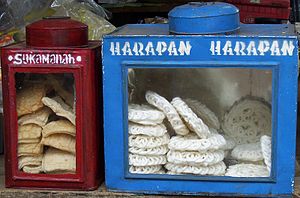
Traditional crackers are called krupuk, made from bits of shrimp, fish, vegetables or nuts, which are usually consumed as a crunchy snack or to accompany main meals. These crispy snacks sometimes are added upon the main meal to provide crunchy texture; several Indonesian dishes such as gado-gado, karedok, ketoprak, lontong sayur, nasi uduk, asinan and bubur ayam are known to require specific type of krupuk as toppings. There are wide variations of krupuk available across Indonesia. The most popular ones would be krupuk udang (prawn crackers) and krupuk kampung or krupuk putih (cassava crackers).
Other popular types include krupuk kulit (dried buffalo-skin crackers), emping melinjo (gnetum gnemon crackers), and kripik (chips or crisps), such as kripik pisang (banana chips) and keripik singkong (Cassava chips), rempeyek, is a flour-based cracker with brittle of peanuts, anchovies or shrimp bound by crispy flour cracker, rengginang or intip (Javanese) is rice cracker made from sun-dried and deep fried leftover rice.
Fruits


Indonesian markets abound with many types of tropical fruit. These are an important part of the Indonesian diet, either eaten freshly, or made into juices (such as jus alpukat), desserts (such as es buah and es teler), processed in savoury and spicy dishes like rujak, fried like pisang goreng (fried banana), cooked into cakes (such as kue pisang or bika ambon), sweetened and preserved such as sale pisang and manisan buah, or processed into kripik (crispy chips) as snacks like jackfruit or banana chips.
Many of these tropical fruits such as mangga (mango), manggis (mangosteen), rambutan, cempedak, nangka (jackfruit), durian, jambu air, duku (langsat), jeruk bali (pomelo), belimbing (carambola), kedondong and pisang (banana), are indigenous to Indonesian archipelago; while others have been imported from other tropical countries, although the origin of many of these fruits might be disputed. Klengkeng (longan) were introduced from India, semangka (watermelon) from Africa, kesemek from China, while alpukat (avocado), sawo, markisa (passionfruit), sirsak (soursop), nanas (pineapple), jambu biji (guava) and pepaya (papaya) were introduced from the Americas. Many of these tropical fruits are seasonally available, according to each species flowering and fruiting seasons. While certain fruits such as banana, watermelon, pineapple and papaya are available all year round.
Today, Indonesian markets is also enrichen with selections of home-grown non-tropical fruits that is not native to Indonesia. Strawberry, melon, apple, pear and dragonfruit are introduced and grown in cooler Indonesian highlands such as Malang in mountainous East Java, Puncak and Lembang near Bandung, to mimic their native subtropics habitat.
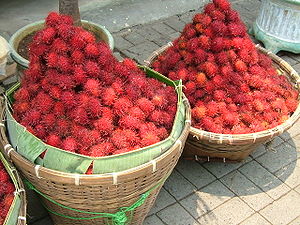
In the last few years, fruit chips have been more and more various. In the old times, banana and jackfruit chips were the most common, but now Indonesian fruit chips are also made from strawberry, apple, dragonfruit, pepino, watermelon, melon, more. Malang, a city in East Java, is the centre of fruit chip production aside from tempeh chips.
Banana and coconut are particularly important, not only to Indonesian cuisine, but also in other uses, such as timber, bedding, roofing, oil, plates and packaging. Banana leaf and janur (young coconut leaf) are particularly important for packaging and cooking process, employed to make pepes, lontong and ketupat.
Health
Nutrition

Much carbohydrate intake in Indonesian cuisine comes from rice, while in eastern parts of Indonesia, yam and sago are common. Indonesian protein intake comes from soy bean products that are processed into tofu and tempeh. Chicken eggs, poultry and meats are also consumed. Most of the fat intake comes from cooking oil (coconut oil) of fried dishes, coconut milk, peanuts, as well as meats and offals.
Some Indonesian fruit and vegetable dishes such as fruit rujak, gado-gado, karedok, pecel, lalab, capcay, tofu and tempeh are foods with low fat and high fibre. Tempeh, for example, is a vegetarian substitute for meat. Some dishes, especially gorengan (deep-fried fritters) and those dishes infused or caramelised with coconut milk, such as rendang and gulai, might taste succulent but are rich in saturated fat.
食の安全性
伝統的なインドネシアの家庭料理は、加工品、缶詰、保存食品をほとんど、あるいは全く使わずに毎日作りたてが食べられる。これは、保存料やナトリウムの量が最小限に抑えられていることを意味する。ほとんどの食材は早朝に地元の伝統的な市場で新鮮なものが購入され、午前中に調理されて主に昼食として消費される。残った料理は、食器棚やテーブルの上に「トゥドゥン・サジ」(虫や他の動物から食品を守るために編まれた竹製のフードカバー)で覆われ、すべて室温で保管され、夕食時に温め直して再び食べられる。 伝統的に、インドネシア料理は長期間保存されることはほとんどなく、ほとんどの料理はその日のうちに調理され消費される。乾燥食品、塩漬け食品、加工食品には一部例外がある。例えば、乾燥したルンダンは数日間は安全に食べられる場合がある。現代の冷蔵技術はほとんどの家庭で利用できる。
衛生
インドネシアの食料品や中級から高級な飲食店で提供される食品のほとんどは、Badan Pengawasan Obat dan Makanan(インドネシア食品医薬品監督庁)によって規制・監督されており、良好から許容範囲の食品衛生基準を維持しているが、一部のワルン(伝統的な屋台)や露天商では衛生状態が悪い場合がある。また、熱帯の微生物は、特にインドネシア滞在中の外国人において、主に胃腸炎などの食中毒の事例を引き起こす可能性がある。そのため、ボトル入りの飲料水や沸騰させた飲料水を飲むか、露天商で売られている未調理の常温食品ではなく、加熱調理された温かい食品を選ぶことが賢明である。
関連項目
Bibliography
- オーウェン, スリ. "Indonesian Food and Cookery" ISBN 978-0907325000, Prospect Books, 1980.
- オーウェン, スリ. "Sri Owen's Indonesian Food" ISBN 978-1910496718, Pavilion Books, 2015.
- ウォンソ, ウィリアム. "Flavors of Indonesia: William Wongso's Culinary Wonders", ISBN 978-9798926327 Bab Publishing, 2016.
- フォード, エレノア. "Fire Islands: Recipes from Indonesia", ISBN 978-1911632047 Murdoch Books, 2019.
外部リンク
| この記事は、クリエイティブ・コモンズ・表示・継承ライセンス3.0のもとで公表されたウィキペディアの項目Indonesian cuisine(13 June 2025, at 11:06編集記事参照)を翻訳して二次利用しています。 |







